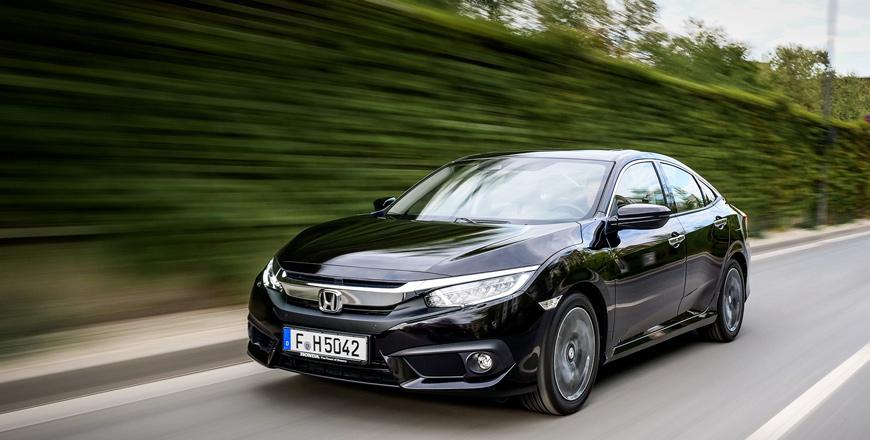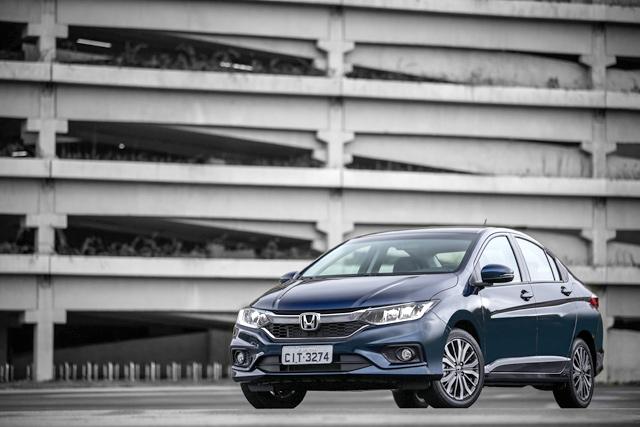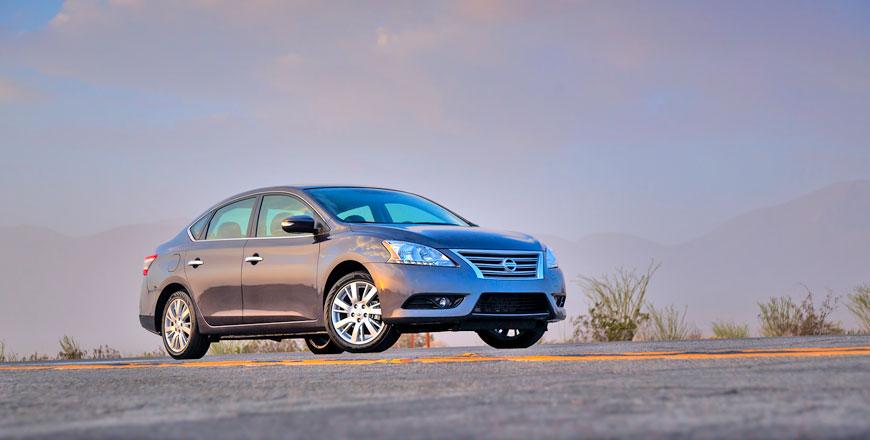You are here
Honda Civic 1.6 DX: seamless, smooth and civil
By Ghaith Madadha - May 06,2019 - Last updated at May 06,2019

Photo courtesy of Honda
Now in its tenth iteration since first launched as a somewhat frumpy yet efficient, reliable and affordable hatchback back in 1972, the modern Honda Civic is a mainstream compact car distinguished by its striking design, smooth driving and responsive handling.
Sold in Jordan as a saloon, but also available globally as a hatchback and coupe, and with a broad range of engines for different markets, the Civic proved impressive even in entry-level specification, as driven briefly on Jordanian roads in 1.6 DX guise.
Sporty style
Longer and heavier than its predecessors, the latest incarnation Honda Civic first arrived as a more refined and mature offering to compete with the larger end of the compact saloon segment, including the Volkswagen Jetta, Nissan Sentra and Toyota Corolla, to mention but a few.
A more complex design with a moodier, sportier and more overtly aggressive design and fashionably low-slung roofline, the latest Civic ditches its predecessors’ clean surfaces and neutral aesthetic character. Instead, it features more bulging bodywork with wavy, almost Coke-bottle wheel-arches and waistline.
With a snouty grille featuring a thick slat that extends across and atop its squinting, recessed and heavily browed headlights, the latest Civic has a distinctly sport demeanour that includes big lower side intakes, scalloped edge bonnet and a rakish roofline that trails off towards a ridged rear deck.
At the rear, the Civic features faux bumper vents and slim boomerang lights framing its fascia. Fastback-like in profile the Civic saloon’s conventional rear boot has a low load height and taller vertical measurement to compensate for its short horizontal length in terms of access.
Eager and willing
The smaller of two naturally-aspirated engines available, and offered alongside various turbocharged engines, the Civic DX’s 1.6-litre four-cylinder is a single overhead camshaft design, yet with 16-valves. Equipped with Honda’s variable valve timing and lift control i-VTEC system, it is a relatively high-revving engine with a 6,700rpm rev limit and its 123BHP output peaking at 6,500rpm, while maximum torque is delivered at 4,300rpm.
Progressive and smooth in delivery, the Civic 1.6 does, however, become somewhat more eager, athletic and responsive as the rev counter tilts ever nearer towards the red line.
Capable of motivating its restrained 1,255kg weight through the 0-100km/h sprint in an estimated 11.6-seconds and on to a 196km/h maximum the Civic 1.6 is reasonably quick given its power output, while fuel consumption is modest at 6.7l/100km, combined.
Driving the front wheels through a continuously variable transmission (CVT), the Civic 1.6 is willing and eager to redline, unlike some CVT vehicles. Using a more robust and durable timing chain design instead of a belt, the Civic’s engine whines slightly when pushed hard to near its rev limit.
Nimble yet confident
Seamlessly smooth in delivery when driven in auto mode, the Civic’s CVT doesn’t seem to discourage high revs like some CVT systems, and can also shift through pre-set ratios through the gear lever, for a more involving drive that mimics a traditional gearbox.
Similarly smooth and settled in its ride quality, the Civic felt alert and light on its feet, yet reassuringly stable and refined at speed, while road imperfections were well dispatched with the base DX model’s un-exaggerated 215/55R16 tyres providing mostly good comfort and absorption, if being slightly firm over some more sudden ridged textures and bumps.
A tidy and fluent driving car with light, quick-turning steering that is direct and well-insulated, the Civic tucks eagerly into a corner, with reassuring front grip, good body roll control and confident adherence to a chosen cornering line, while modest width tyres allow for good steering feel for a modern electric-assisted system.
Responsively changing directions, it has a nimble and agile feel, but remains well planted on the road. Grippy through corners with its independent MacPherson strut front and multilink rear suspension, the new Civic’s longer wheelbase helps maintain stability, if at the cost of some mid-corner adjustability.
Refined ride
Well-refined inside from noise, harshness and vibrations, even if its engine sound rises slightly at high revs, the Civic feels sophisticated, sporty and smooth. A more-driver-oriented car than many compact saloon rivals, the Civic provides a supportive, comfortable and alert driving position with good front road and instrument visibility, and good semi-electric driving seat and steering wheel adjustability.
Easy to accurately place on the road, the Civic’s sleek low roofline and rakishly slanted pillars does reduce rear and side visibility slightly, compared with a boxier and taller design.
With logical, clean and user-friendly layouts and controls inside combine with a good low driving position, the Civic has an air of effortless civility about it. Meanwhile material used is mostly decent — if not luxurious quality — but seems well built and pleasant.
Driven in entry-level DX trim, the Civic’s equipment level covers most of the important things, but for more sophisticated and advanced driver aids, like useful lane departure and blind spot monitoring systems, one would need to upgrade to a higher specification.
Standard fabric upholstery meanwhile has a nice feel but would be better in a darker tone than the driven demo car’s light beige. Spacious in front and with a generous 519-litre boot and good rear legroom owing to its longer wheelbase, the Civic low roofline does, however, reduce rear headroom for tall adults.
TECHNICAL SPECIFICATIONS
Engine: 1.6-litre, transverse 4-cylinders
Bore x stroke: 81 x 77.5mm
Compression ratio: 10.7:1
Valve-train: 16-valve, SOHC, variable valve timing and lift control
Gearbox: Continually variable transmission (CVT), 7-speed auto, front-wheel-drive
Power, BHP (PS) [kW]: 123 (125) [92] @6,500rpm
Specific power: 94.5BHP/litre
Power-to-weight: 98BHP/tonne
Torque, lb/ft (Nm): 111 (151) @4,300rpm
Specific torque: 207.3Nm/litre
Torque-to-weight: 120.3Nm/tonne
Rev limit: 6,700rpm
0-100km/h: 11.6-seconds
Top speed: 196km/h
Fuel consumption, urban/extra-urban/combined:
9.2-/5.2-/6.7-litres/100km
Fuel capacity: 47-litres
Length: 4,630mm
Width: 1,799mm
Height: 1,416mm
Wheelbase: 2,700mm
Track, F/R: 1,543/1,577mm
Ground clearance: 133mm
Luggage volume: 519-litres
Kerb weight: 1,255kg
Steering: Electric-assisted rack & pinion
Turning Circle: 11.5-metres
Lock-to-lock: 2.22-turns
Suspension, F/R: MacPherson struts/multi-link
Brakes, F/R: Ventilate discs/discs
Tyres: 215/55R16
Related Articles
Now in its tenth iteration since first launched as a somewhat frumpy yet efficient, reliable and affordable hatchback back in 1972, the mode
Reinvented in 1996 as a compact saloon car aimed largely at developing markets rather than small hatchback model that would be succeeded by
Positioned between similarly sized Japanese competitors like the Honda Civic and Toyota Corolla, and rugged, slightly smaller, and more affo


















